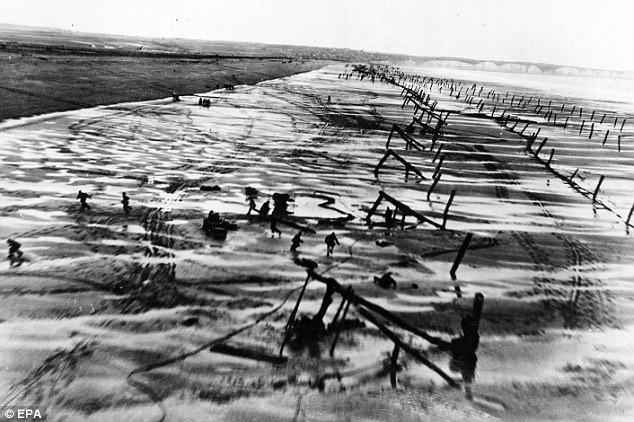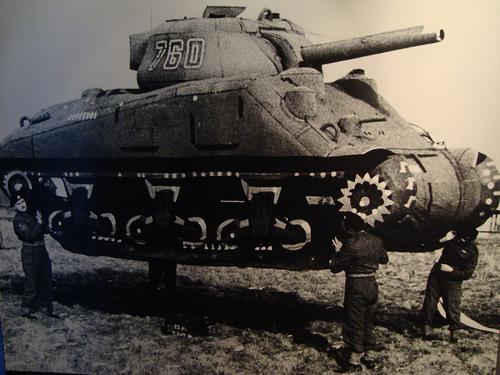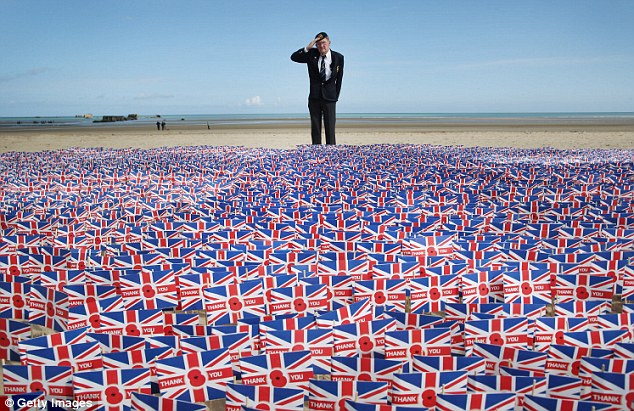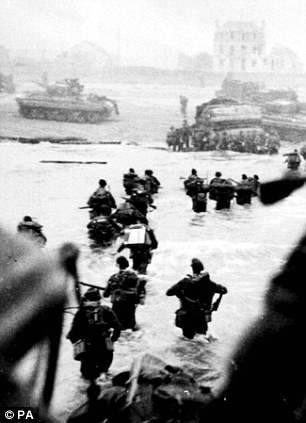Today’s commemoration of the 70th anniversary of D-Day is one of the last at which a diminishing band of the men who took part will be present.
A few cynics will say: Time to move on, anyway. We live in a new world. Should we not forget about the Second World War, and get on with our new century?
But if there was one moment of the struggle which represented the zenith of our national achievement, the finest of British endeavours in peace or war, then it must be what was done by millions of our people of all ages and both sexes to make possible the triumph of the landings in Normandy on June 6, 1944.
After all, D-Day was a mainly British undertaking.
For all the critical contribution of the United States, this was the last great operation of the war in which the British took the lion’s share, and earned a lion’s share of the credit.
Think of the myriad British people involved, from the women industrial workers who made the ammunition to the WAAFs who packed parachutes, the WRNS who manned ops rooms.
British workmen built the huge artificial Mulberry harbours which Churchill himself had conceived, to be towed in sections to France and shelter both British and American supply vessels offloading from volatile Channel weather during the first weeks after the landings.
Clever British geeks devised a compound of grease, lime and asbestos fibres to waterproof vehicles. Others designed what were known as ‘the funnies’ — tanks modified to swim, or carry fascines (rolled-up bundles of wood) to bridge ditches, mortars to destroy pillboxes, flame-throwers and flails to explode mines.
Curiously the Americans, usually the most mechanically-minded people on earth, spurned these Limey gadgets — and paid a heavy price for doing so when The Day came on the beaches.
Then there were the high commanders. General Sir Bernard Montgomery had been a celebrity since his victory at El Alamein in November 1942, but he was also intensely controversial — hated by the Americans, who thought him slow in action, unforgivably rude and patronising in speech.
But, under Dwight Eisenhower’s nominal Supreme Command, the operational plan for D-Day was overwhelmingly Monty’s. He directed both the landings and subsequent campaign ashore.
Even most of his critics conceded that nobody else could have done it better, from the moment early in 1944 when he insisted that the number of troops attacking on the first day should be doubled, whatever the difficulties about finding extra shipping to carry them.
The British people's greatest day: Cynics will say it's time to move on. But today raise a glass to the sheer ingenuity, courage and bloody mindedness of Britons like Stan Hollis, who turned a potential disaster into awesome victory
By Max Hastings
5 June 2014
Daily Mail

Great British hero: Stan Hollis was awarded the Victoria Cross for his extraordinary actions during the fighting
Today’s commemoration of the 70th anniversary of D-Day is one of the last at which a diminishing band of the men who took part will be present.
A few cynics will say: Time to move on, anyway. We live in a new world. Should we not forget about the Second World War, and get on with our new century?
As a historian, I resist myth-making about our past. Not everything that happened between 1939 and 1945 deserved applause.
But if I had to single out one moment of the struggle which represented the zenith of our national achievement, the finest of British endeavours in peace or war, then it must be what was done by millions of our people of all ages and both sexes to make possible the triumph of the landings in Normandy on June 6, 1944.
Consider all that had gone before. Despite Winston Churchill’s proud defiance and the RAF’s wonderful achievement in the Battle of Britain, between 1940 and 1942 the British Army suffered repeated defeats and indeed humiliations, often at the hands of smaller numbers of Germans or Japanese.
The Royal Navy performed brilliant service, but suffered terribly fighting through the Atlantic, Arctic and Mediterranean convoys, enduring brutal pain at the hands of U-boats and the Luftwaffe.
It was memories of so many failures that made Churchill acutely apprehensive about D-Day, fearful to the last that something terrible could happen in Normandy.
As late as February 1944, amid a fit of depression he cried out: ‘Why are we trying to do this?’ He briefly urged an alternative Allied landing in Portugal.
Likewise, the head of the Army, that fine soldier General Sir Alan Brooke, wrote bleakly on June 5 about the invasion: ‘At its best, it will fall far short of the expectations of the bulk of the people, namely all those who know nothing about its difficulties. At its worst, it may well be the most ghastly disaster of the whole war.’
Yet on the day, every such fear was confounded. And for all the critical contribution of the United States, this was the last great operation of the war in which the British took the lion’s share, and earned a lion’s share of the credit.
Think of the myriad people involved, from the women industrial workers who made the ammunition to the WAAFs who packed parachutes, the WRNS who manned ops rooms.

A photograph released by the Ministry of Defence shows German defences on the French coast before D-Day. Top military brass were terrified the invasion would go awry
Then there were the high commanders. General Sir Bernard Montgomery had been a celebrity since his victory at El Alamein in November 1942, but he was also intensely controversial — hated by the Americans, who thought him slow in action, unforgivably rude and patronising in speech.
But, under Dwight Eisenhower’s nominal Supreme Command, the operational plan for D-Day was overwhelmingly Monty’s. He directed both the landings and subsequent campaign ashore.

Normandy, France, June 1944. A composite aerial photograph of a British 'Mulberry' artificial harbour at the beach head after the landings on June 6, 1944
Even most of his critics conceded that nobody else could have done it better, from the moment early in 1944 when he insisted that the number of troops attacking on the first day should be doubled, whatever the difficulties about finding extra shipping to carry them.
Then there were the staff, thousands of officers often caricatured as boring blimps, almost all civilians in uniform, who worked for months in dreary huts and offices, converting the great plan into reality.
Millions of maps had to be printed in conditions of absolute secrecy; 25 square miles of south Devon cleared of the civilian population to enable amphibious training; arrangements made to ship two million men, 200,000 vehicles, 4,000 tanks and 6,000 artillery pieces from Britain to France.
British workmen built the huge artificial Mulberry harbours which Churchill himself had conceived, to be towed in sections to France and shelter both British and American supply vessels offloading from volatile Channel weather during the first weeks after the landings.
Clever British geeks devised a compound of grease, lime and asbestos fibres to waterproof vehicles. Others designed what were known as ‘the funnies’ — tanks modified to swim, or carry fascines (rolled-up bundles of wood) to bridge ditches, mortars to destroy pillboxes, flame-throwers and flails to explode mines.
Curiously the Americans, usually the most mechanically-minded people on earth, spurned these Limey gadgets — and paid a heavy price for doing so when The Day came on the beaches.

British troops moving an inflatable tank: The intelligence planners – again, overwhelmingly British amid American scepticism – forged the superlative Operation Fortitude
The intelligence planners – again, overwhelmingly British amid American scepticism – forged the superlative Operation Fortitude, the greatest deception in history, to keep the Germans guessing first about where the invasion would come, and later about whether another landing would follow elsewhere.
Operation Fortitude required collaboration between the code decrypters of Bletchley Park, the MI5 officers controlling German double-agents in Britain, the RAF’s reconnaissance squadrons and thousands of army signals personnel impersonating dummy units, which were used to deceive the Germans on troop positions.
It worked brilliantly: Hitler kept vital forces in the Pas-de-Calais — well to the north of the Normandy beaches — until August, amid his high command’s chronic uncertainty about what the Allies might do next.

The Allies faced a deadly challenge. General Sir Alan Brooke wrote bleakly on June 5 about the invasion: 'At its best, it will fall far short of the expectations of the bulk of the people, namely all those who know nothing about its difficulties. At its worst, it may well be the most ghastly disaster of the whole war'
Then there was the Royal Navy, led by the brilliant Admiral Sir Bertram Ramsay. Having controlled the 1940 Dunkirk evacuation, he now directed the huge fleet of warships, transport and landing craft which bore the armies to France.
In advance of the landings, late in January a British midget submarine — known as an X-craft — carried two secret swimmers into the beaches by night.
A sapper named Captain Scott-Bowden and Sergeant Bruce Ogden Smith, a member of the Special Boat Section from a famous family of fishing-tackle makers, probed the sand with auger drills within yards of German sentries before returning home bearing samples so it could be established whether the target beaches could take the weight of the tanks.
At dawn on June 6, X-craft again played a role, providing beacons to guide the armada inshore, while thousands of sailors directed landing craft and manned the guns of bombarding warships. Overhead, hundreds of squadrons of RAF bombers and fighters spearheaded the huge air operation in support of the assault.
The word hero is often foolishly abused to describe anybody who took part in the Second World War, whether wielding a pen as an Army office clerk at Aldershot, or enduring the whitest heat of battle as an infantryman.

Veteran Fred Holborn, from the Fleet Air Arm, salutes as he looks at British Legion Union flags carrying thank you messages planted in the sand on Gold beach yesterday
We should not expect everybody who wears a uniform to be brave. But on D-Day, an extraordinary number of men did extraordinary things, which deserve our awe to this day.
Think of Major John Howard, the former policeman who led his men of the Oxfordshire and Buckinghamshire Light Infantry to storm the Orne Canal crossing — what became known to posterity as Pegasus Bridge — just after midnight on June 6, and of the glider pilots who performed the dazzling feat of airmanship that enabled them to crash-land their flimsy planes almost intact beside Howard’s objective.
Recall the men who drove amphibious tanks through choppy seas which sometimes swamped and drowned them; those who parachuted into action with 6th Airborne Division; Lord Lovat and his commandos led by his personal piper; the foot-soldiers who stormed the German positions behind the beachhead.

Invasion: An aerial view of Sword Beach on D-Day, 1944
At the top of my personal pantheon is a lanky, gap-toothed 32-year-old Yorkshireman named Stan Hollis. Born in Middlesbrough, the son of a labourer, Hollis suffered a familiar range of sorrows and privations through the 1930s Depression.
He was briefly a Merchant Navy cadet, then a lorry driver with long spells out of work. He joined the Green Howards regiment as a Territorial Army soldier, and in 1940 sailed with them to France as a private.
Through the years that followed, Hollis became famous among his mates for his fantastic courage, displayed first at Dunkirk, then in the desert and Sicily. He attacked a tank single-handed at El Alamein, and engaged in personal duels with the Germans which he had no right to survive.
Long afterwards, his commanding officer, Lt-Col Robin Hastings — no relation, alas — said to me: ‘You know, I think Hollis was the only man I met in the whole war who felt that winning it was his personal responsibility. Almost everybody else, if they found some bloody awful job had to be done, would mutter, “Please God some other poor b****r will do it”.’

The fight for Europe: Commando troops coming ashore from landing craft
D-Day found Stan Hollis a sergeant-major in a landing craft approaching Gold Beach, firing a Lewis gun at the German defences. Just before they lurched to a halt inshore, he rashly grabbed the gun by its white-hot barrel, giving himself a burn which proved his most agonising wound of the morning.
The first man down the ramp in front of Hollis, a fine soldier named Sergeant Hill, plunged deep into a shell-hole concealed by the sea, where under the deadweight of his ammunition and equipment he sank without trace.
Hollis waded ashore with his company, narrowly escaping death when the steel escape hatch of an exploded tank whirled through the air beside him, almost taking off his head.
An Irishman named Mullally, who was killed a few moments later, gazed in amazement at a row of birds perched on German barbed wire beneath the torment of shelling and small-arms fire and said: ‘No bloody wonder they are there sergeant major, there’s no room in the air for them!’
Stan Hollis’s company commander spotted a German position from which came fierce machine-gun fire and said: ‘There’s a pillbox there, sergeant-major!’

General Sir Bernard Montgomery had been a celebrity since his victory at El Alamein in November 1942, but he was also intensely controversial
Hollis never hesitated. He cocked his Sten gun and dashed forward alone, straight for the enemy, firing bursts as he went, then tossed a grenade through the gun slit. As it exploded, he ran around the back and burst inside. He met two dead Germans, and a cluster of others who promptly surrendered.
Seeing another nearby pillbox, he ran along a connecting trench and took prisoner its occupants, too. Then he gestured the whole lot, 20 in all, down towards the beach.
A few hours later, Hollis did exactly the same again in a Norman farmyard, running headlong at a German machine-gun post.

Stoic: Allied troops wading through the sea to the Normandy shore during the D-Day landing
For his suicidally courageous morning’s work, two months later he was awarded a Victoria Cross. He shrugged modestly: ‘There wasn’t only me doing these things, there was other people doing things as well.’ He was right about that.
But when he added: ‘The things that I did, if I hadn’t done them, somebody else would have done them’, we may doubt his word. No army can win its battles without a few, just a very few, amazing men like Stan Hollis.
He should be remembered as a shining example of the sort of British soldier who made victory possible.
Countless books continue to be written about D-Day, partly because there is no end to the tales of achievement, sacrifice and courage.
The saga defies cynicism, because it signalled the beginning of what Eisenhower later called ‘The Crusade for Europe’.
This had a unique resonance for the British people, because since 1939 they had endured so much, and suffered so many failures and setbacks, on the long, hard road back to France.
Today we justly acknowledge that Russian blood and American resources played critical roles in smashing Nazism, bringing final victory in 1945. But every British man, woman and child who cherishes our heritage should celebrate the anniversary of this event that stands close to 1940 as our forefathers’ finest hour.
Indeed, this was a much happier historical moment. In the year of the Battle of Britain, the nation was merely averting disaster. But on June 6, 1944, British genius and courage held the forefront as the forces of freedom took the first great stride towards the liberation of Western Europe.
Raise a glass today, to the memory of all those magnificent men, from the boffins, planners and industrial workers to the aircrew, soldiers and sailors, from Winston Churchill through John Howard to Stan Hollis, who did very great things to make possible the triumph of June 6, 1944.
They were, indeed, the Best of British.

Read more: On D-Day's anniversary, raise a glass to Britons who turned potential disaster into victory | Mail Online
Follow us: @MailOnline on Twitter | DailyMail on Facebook
Last edited: